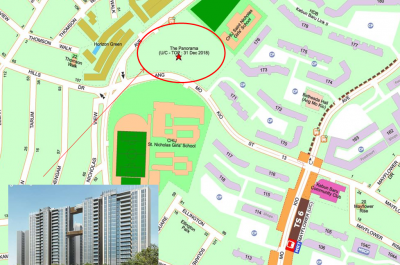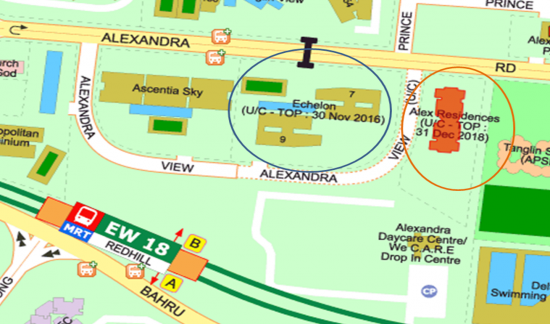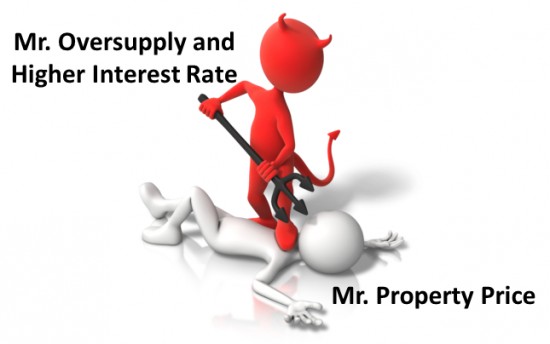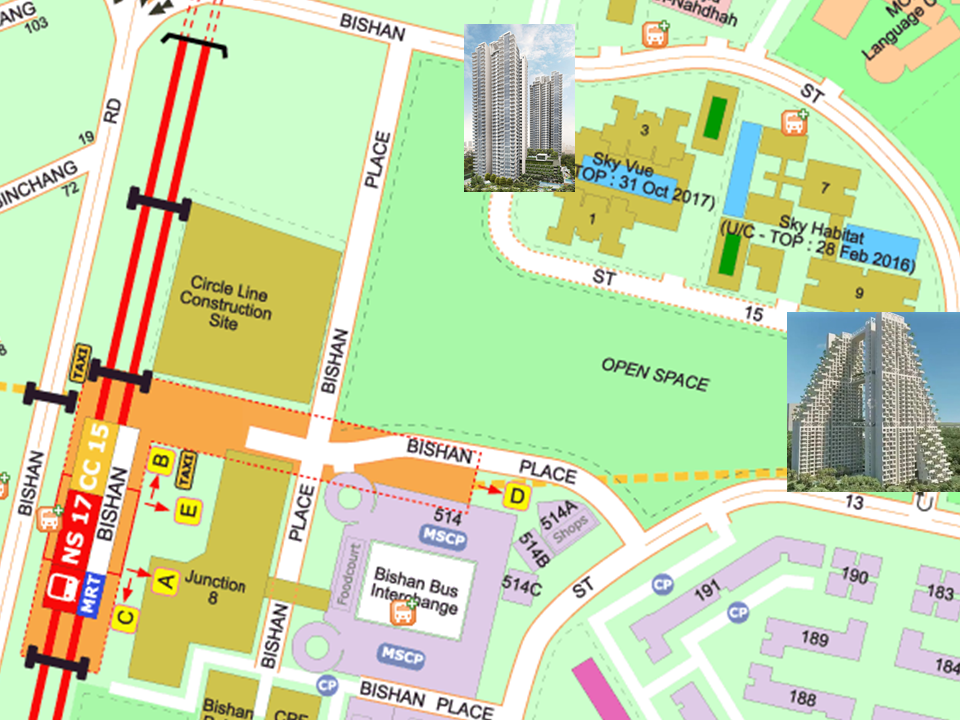The Property Winner’s Curse claims a Victim – 7 Mar 2014


=================================================================
In its recent foray into the heartlands, Wheelock Properties (“Wheelock”), a luxury property developer which has relatively little experience in building condos in the heartlands, shelled out $550m to outbid a field of 11 other competitors and won the rights in Jan 2013 to build The Panorama, pretty much a quality mid-range condo in Ang Mo Kio Ave 2.
CapitaLand, the 2nd highest bidder at $14m less, must be heaving a huge sigh of relief. It definitely would not want a repeat scenario of stuck inventory at Sky Habitat in heartland Bishan.
Why? Just a few days ago, Wheelock made an accounting provision of $110 million loss for The Panorama. Not surprising, given that it had been able to move only 58 out of 698 units so far (less than 9%) as at end Jan 14.
Our Finance Minister’s recent stand in Budget 2014 that it is too early to start relaxing property cooling measures means that our government is far from relenting, despite strong appeals from developers to loosen things up a bit. Many are reporting tighter margins and in some cases preparing for losses for some projects.
Just like property investors who have to be careful with timing entry in property investments, the same goes for deep pocket property developers. No one is spared from this simple yet profound logic.
Will the bargains start rolling in the next few months? Stay tuned!
Our Best, Always
Share our postings, be our Facebook Ambassador and win prizes!
The Property Bubble across the Causeway – 19 Feb 2014

=================================================================
Property oversupply across the causeway? Well, Johor Real Estate and Housing Developers Association (Rehda) chairman Koh Moo Hing thinks so as he cited the flooding of mega projects by China property developers.
The number of new homes being built in Johor is estimated to be about 40 to 45% of the current stock. Recent launches in Iskandar range between RM800 and 1,200 per square foot, with prime units going for RM1,800 psf and above. The entry of China-based Country Garden Holdings, with its mega-launch of 9,000 apartment units at one go has gotten local developers worried, with some believing the magnitude and scale of such launches could lead to a property bubble. What is interesting is the unrefuted rumour that Country Garden has been offering its Chinese buyers a deal that packages the purchase of a property in China with a unit in Iskandar to boost sales.
Close at Country Garden’s heels is Hong Kong-listed Guangzhou R&F Properties, which recently bought 116 acres in Johor Bahru from the Sultan of Johor for RM4.5 billion to develop what has been said to be another mega-mixed development.
Not far behind is Hao Yuan Investment, a China-linked company that is forming a joint venture with Iskandar Waterfront Holdings to develop 15 hectares in Danga Bay.
Post-Malaysia Budget 2014 has seen poor take-up rates with developers failing to register healthy bookings for new projects even in the prime area of Puteri Harbour. For those not yet invested in the property market across the causeway but are thinking of doing so, do conduct your due diligence! This is critical in the face of a softening market across the Causeway.
Our Best, Always
Learning from Ireland’s Property Bust – 30 Dec 2013

============================================================
In 2004, Ireland was one of the world’s wealthiest countries and the year after, was judged to have the world’s best quality of life. On the back of low corporate tax, it attracted a lot of foreign direct investment by European MNCs, which fueled its economic growth. Yet, it went all wrong so quickly through a series of missteps. Public spending rose dramatically while income tax was cut. Then, government policies “encouraged” property speculation and allowed a huge housing bubble to develop.
House price growth between 2001 and 2007 was a bubble, driven by banks over-extending themselves (lending relative to deposits) and over-extending borrowers (higher loan-to-value). The sharp rise in property forced rental yields down. When the economic crisis came, investors who were already cash flow negative since rental income did not cover holding costs exited in a hurry, helping to force house prices down.
In 2010, Ireland was forced to take an economic bail-out from the European Union of more than €67bn (SGD117bn) from the IMF and the EU to rescue the country from bankruptcy. What a reversal of fortune in a mere matter of years!
The credit-fuelled boom in property that caused the spectacular crash, affected Irish citizens from all walks of life. Lead Singer of popular Irish boy band Westlife, Shane Filan, was also a casualty. Like many highly indebted Irish property developers, he filed for bankruptcy as the property development company he started with his brother collapsed under a mountain of debt. Before the economic crisis hit, Shane and his brother Finbarr had borrowed millions from several banks in Ireland. Recently, he came back as a solo artiste (after Westlife disbanded) to start all over again.
Today in 2013, Irish property prices in general, are about 50 per cent below their peak in 2007. The Irish Government estimates that there are 1,300 so-called ghost estates and hundreds of thousands of unoccupied new homes, abandoned by developers and investors gone bust. Some abandoned projects are in such bad shape that the Irish government is actually demolishing them as they are posing health and safety risk to people around them.
Will this happen in Singapore? This recent Irish property bust fallout has been studied by many governments around the world and many know the consequences of allowing a property bubble to go unchecked. You can certainly bet on our government to engineer a soft-landing no matter what.
Our Best, Always!
December cooling measures for ECs – 17 Dec 2013

===============================================================
By now, you would have read about the latest cooling measures for Executive Condos (ECs). What we’ve read in the news so far are topline comments from analysts that HDB flat upgraders are likely to be the hardest hit by the changes. Is it that true? First the 2 main changes.
A) Resale Levy for Second-Timer Applicants
The levy will range from S$15,000 to S$50,000 depending on the flat type of their first HDB property.
B) Revision of Mortgage Loan Terms
The Monetary Authority of Singapore (MAS) will cap the Mortgage Servicing Ratio (MSR) for housing loans granted by financial institutions for EC units bought directly from property developers at 30% of a borrower’s gross monthly income.
Let’s go through some numbers and draw some implications
Going by the maximum cap of $12,000 household income for ECs, a 30% cap will mean $3600 used for loan servicing. Just for illustration purpose, assuming an average 25 years loan, (more realistic) for a typical couple in their early to mid 30s, they can take a maximum loan of about $720,000 (MAS require banks to use 3.5% interest rate to compute mortgage servicing). Since banks can only loan up to 80%, this means that the purchase price will be at max, $900,000.
As our example uses pretty much a scenario for a couple that is at the extreme upper end of the EC buyer profile, it is reasonable to say that the sticker price of $900,000 calculated is near the maximum price that new EC units (where the Option to Purchase is granted on or after 10 Dec 2013) will sell for. If we stretch our parameters a bit, using a 30 years loan tenure, a sticker price of $1 million can be achieved.
But developers know their sums. To avoid stuck inventory, we expect that going forward, developers will try not to launch any EC unit for $1 million and more unlike previous EC launches in 2013 where many of the larger EC units were priced more than $1 million.
Should developers sensibly bid more cautiously for the latest 2 EC sites at Choa Chu Kang Grove, launched for sale yesterday, you could be looking at ECs in 2014 launched at 690 to 750 psf instead of the 800+psf we have seen in 2013.

We’re quite sure the government is watching closely. Very, very closely. Would the government start to regulate the minimum size for different EC unit configuration to re-align ECs more closely to pubic housing? Already they have capped the maximum size of an EC unit to 160 sqm. Watch this space!
Our Best, Always
A 2nd tale of 2 condos – Echelon vs Alex – 14 Nov 2013

=================================================
1) It happened again. Just like how Sky Vue was priced lower than an earlier launched next door neighbor, Sky Habitat in Bishan, over at Redhill, a similar phenomenon took place.
2) Alex Residences reported that it had sold 150 units yesterday, out of 429-units at an average price of $1,650 psf. Just about a year ago, next door condo, Echelon sold at a higher average of S1,767 psf with an exuberant price of $2,474 PSF paid for a 452 sq ft unit in Jun 2013.
3) And guess what? The land cost for Alex Residences at $970 psf per plot ratio is actually about 29% more expensive than the $754 psf per plot ratio that CDL paid for the Echelon site. More costly land site, yet cheaper psf sale price. You do the interpretation.
4) Anyway, back to the Echelon condo. Jeez, surely the buyer of that 452 sq ft unit would be better off purchasing a unit in Duo Residences that was going for about $2,300 psf for its 1 bedder unit, with a lot more upside.
5) Prices are indeed on the slide down. Those who have exercised some patience have been rewarded. Watch out for more good deals in the horizon.
Our Best, Always!
Summary of latest cooling measures in Malaysia – 6 Nov 2013

=====================================================
The air-con to chill and rein back property speculation has been turned on full blast in Malaysia with the announcement of Malaysia’s Budget 2014. Right now there is no clarity if it applies to all of Malaysia, or if certain strategic zones such as Iskandar will be exempted.
TO SUMMARIZE
1) === Real Property Gains Tax (“RPGT”) ===
First, a bit on RPGT. RPGT is imposed on the net gains from the disposal of the property after deducting the acquisition price and other expenses incurred until the property is disposed. Other expenses include stamp duty, legal fee, cost of renovation, commission for sales and administrative payment. RPGT exemption is given for up to RM10,000 or 10% of the net gains, whichever is higher, from the disposal of real property by all individuals.
For Malaysian Citizens and PRs
30%, for properties disposed within three years of purchase
20%, for the disposal of properties held for four years
15%, for the sale of properties held for five years.
0% for sale of properties held for more than five years
For Foreigners
30% for properties disposed within five years of purchase,
5% for properties sold after being held for more than five years.
(Effective date – For disposal of properties and shares in real property companies from 1 January 2014)
2) === Minimum price of property that can be purchased by foreigners ===
To be raised to MYR1m (SGD391K), from MYR500,000.
3) === Developer Interest Bearing Scheme (DIBS) ===
To be outlawed. Developers can no longer incorporate interest rates on loans in house prices during the construction period. Financial institutions are prohibited from providing final funding for projects involved in the DIBS scheme.
WHAT NOW?
Analysts were largely surprised by the weight of the cooling measures, expecting a lighter touch. To what extent will savvy investors be put off by the increased RPGT? One thing’s for sure. The Malaysian government wants you (as a foreigner) to be a long term investor in higher value property, not a speculator.
Our Best, Always!
Property prices creeping back to saner levels? – 6 Nov 2013

================================================================
It was in the news just a week ago. In the clearest sign of an inventory clearing exercise, The Inflora, a new condo project a short stroll from Changi Prison, a 5km drive from Tampines Mall and nowhere near an MRT station, saw close to 100% take up. The sweetener? Sub $900 psf pricing.
A week later over in Punggol, albeit less spectacular, an Executive Condominium, Waterwoods managed to move about 30% inventory with an average pricing of $800 psf.
Developers are not taking chances. Run of the mill projects have to clear ASAP. For such projects, it is too risky for developers to hold out for high prices and wait for buyers to blink. In the latest set of property statistic released by URA on 25 Oct, several interesting numbers caught our attention.
As at the end of 3rd Quarter 2013, there was a total supply of 84,917 uncompleted private residential units in the pipeline. Of this number, 36.5% remain unsold. If we include 12,436 EC units also in the pipeline, the upcoming inventory stands at 97,353 units. Buyers have choices. Lots of choices, in fact.
Let’s pile it on a little more. Another 10,025 units from Government Land Sales (GLS) sites will be added to the pipeline supply. Including these units, there will be about 107,400 private housing and EC units in the overall pipeline supply, many of which are expected to be completed in 2 to 3 years.
It is no wonder then that a concerned Real Estate Developers Association of Singapore has called on the Government to “calibrate” its land sales programme.
Vacancy rate wise, for completed private residential units, it has increased to 6.1%, up from 5.6% in the previous quarter.
We seem to be approaching an inflexion point in the private residential property market cycle. What will Q4 2013 statistics from URA reveal?
Our Best, Always!
New property tax for foreign property buyers in Johor? – 9 Oct 2013

=========================================================
Latest news about property purchase in Johor where Iskandar is located. A new fee, expected to be 4 to 5 % of the property (new/resale) price might be implemented by year-end or early next year and will apply to all properties (commercial/industrial/residential).
This new fee if implemented (applicable only to foreign buyers) will not deter Singaporeans from snapping up properties in Iskandar as most Singaporeans only use Singapore higher property prices as a reference point in buying “cheaper” properties across the Causeway.
The risk in buying such properties is very real due to the opaque property transaction information in Johor.
Nevertheless if you do invest in properties in Johor, do ensure that the project is a unique one and not a usual run of the mill kind, otherwise when it comes to disposal, you will not have a easy time. Do not use Singapore’s usual buoyant resale market as a reference point. You are just looking through the wrong end of your binoculars.
Our Best, Always!
Residential property – A 20% price correction? – 9 Oct 2013

===================================================================
In a report issued on 5th October (Fri), Barclay warned that general residential property prices could be headed for 10 to 20% correction from the peak of 1H 2013.
Their report revealed nothing new that we have not shared with our participants and members. Large oversupply coming on board in the next few years and higher interest rates is expected to drive selling pressure. Also, the 4 years seller stamp duty on residential properties would have reached its tail end by then, giving investors more motivation to offload.
Of course, the 20% drop if it happens will not occur overnight but over the next few years. Barclay forecasted that prices will stabilized/remain flat in 2013 (Yes, we are already seeing this with developers reducing/holding prices), before falling 5% in 2014 (reasonable assumption) and another 5 to 15% in 2015.
Our independent research shows that residential property prices in general over the past 2 to 3 years have advanced well over 20%. Hence a correction of 10 to 20% over the next 2 to 3 years will not be surprising. It’s just bringing us back to saner acceptable levels.
Our Best, Always!
A tale of 2 condos (Sky Habitat vs Sky Vue) – 19 Sep 2013

=====================================================================
Most recently, CapitaLand announced its pricing for Sky Vue in Bishan, about a 4 to 5 min walk from Junction 8 and Bishan MRT.
What made us sit up however was the difference in launch price. Next door “iconic” neighbor, Sky Habitat, also by CapitaLand, transacted between $1,416 and $1,810 psf, higher than Sky Vue’s launch at $1,380 to $1,550 per sq ft.
The Sky Habitat site was secured at a whopping $870 psf ppr and Sky Vue’s site was secured at about 2% less at $853 psf ppr. One might think that CapitaLand would launch Sky Vue near the same price as Sky Habitat to “protect” the interest of those who had purchased Sky Habitat earlier and maintain the selling price of Sky Habitat.
However, with Sky Habitat less than 40% sold to date after more than a year in the market, perhaps CaptaLand doesn’t want to repeat the pricing mistake it made with Sky Habitat. Remember, CapitaLand had bid overly aggressively for the Sky Habitat site, outbidding the next closest bidder by S$118m or 20% and had to pass the winner’s curse to Sky Habitat’s buyers through clever marketing. Is the “unique design” of Sky Habitat really worth the premium? As an investor, will your tenant pay you a higher monthly rental because of that?
What are the key takeaways? Developers will sell you a project at the price that the market can bear at that point of time. Buy a project at the wrong time and you could be in for a real headache. Sky Vue’s launch price at $1,380 to $1,550 per sq ft suggest that bargaining power is shifting back to buyers. Those who have been waiting patiently by the sidelines like us, well done.
Oh, don’t say we didn’t warn you. See the large open space of land adjacent to Sky Habitat and Sky Vue? That plot is currently HDB’s land and if next generation high rise HDB flats go up, there goes some of your high rise view.
Our Best, Always


